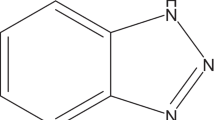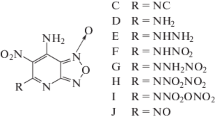Abstract
Dinitroamino benzene derivatives are designed and studied in detail with quantum chemistry method. The molecular theory density, heats of formation, bond dissociation energies, impact sensitive and detonation performance are investigated at DFT-B3LYP/6-311G** level. The results of detonation performance indicated most of the compounds have better detonation velocity and pressure than RDX and HMX. The N-N bond can be regard as the trigger bond in explosive reaction, and the bond dissociation energies of trigger bond are almost not affected by the position and number of substituent group. The impact sensitive are calculated by two different theory methods. It is found that the compounds, which can become candidates of high energy materials, have smaller H50 values than RDX and HMX. It is hoped that this work can provide some basis information for further theory and experiment studies of benzene derivatives.

Similar content being viewed by others
References
Pagoria PF, Lee GS, Mitchell AR, Schmidt RD (2002) A review of energetic materials synthesis. Thermochim Acta 384(1–2):187–204
Xu XJ, Xiao HM, Ju XH, Gong XD, Zhu WH (2006) Computational studies on polynitrohexaazaadmantanes as potential high energy density materials. J Phys Chem A 110(17):5929–5933
Richard RM, Ball DW (2008) Enthalpies of formation of nitrobuckminsterfullerenes: extrapolation to C60(NO2)60. J Mol Struct (THEOCHEM) 858(1–3):85–87
Chavez DE, Hiskey MA, Gilardi RD (2000) 3,3′-Azobis(6-amino-1,2,4,5-tetrazine): a novel high-nitrogen energetic material. Angew Chem Int Ed 39(10):1791–1793
Neutz J, Grosshardt O, Schäufele S, Schuppler H, Schweikert W (2003) Synthesis, characterization and thermal behaviour of guanidinium–5–aminotetrazolate (GA)–a new nitrogen–rich compound. Propellants Explos Pyrotech 28(4):181–188
Chi W, Wang X, Li B, Wu H (2012) Theoretical investigation on the heats of formation and detonation performance in polydinitroaminocubanes. J Mol Model 18(9):4217–4223
Hammerl A, Klapötke TM, Nöth H, Warchhold M, Holl G, Kaiser M, Ticmanis U (2001) [N2H5] + 2[N4C − NN − CN4]2-: a new high-nitrogen high-energetic material. Inorg Chem 40(14):3570–3575
Huynh MHV, Hiskey MA, Chavez DE, Naud DL, Gilardi RD (2005) Synthesis, characterization, and energetic properties of diazido heteroaromatic high-nitrogen C-N compound. J Am Chem Soc 127(36):12537–12543
Göbel M, Karaghiosoff K, Klapötke TM, Piercey DG, Stierstorfer J (2010) Nitrotetrazolate-2 N-oxides and the strategy of N-oxide introduction. J Am Chem Soc 132(48):17216–17226
Manaa MR, Reed EJ, Fried LE, Goldman N (2009) Nitrogen-rich heterocycles as reactivity retardants in shocked insensitive explosives. J Am Chem Soc 131(15):5483–5487
Wang C, Fuller ME, Schaefer C, Caplan JL, Jin Y (2012) Dissolution of explosive compounds TNT, RDX, and HMX under continuous flow conditions. J Hazard Mater 217(30):187–193
McGuire R, Tarver C (1981) Chemical-decomposition models for the thermal explosion of confined HMX, TATB, RDX, and TNT explosives. Lawrence Livermore National Lab, CA
Bellamy AJ, Ward SJ, Golding P (2002) A new synthetic route to 1, 3, 5–Triamino–2, 4, 6–Trinitrobenzene (TATB). Propell Explos Pyrotech 27(2):49–58
Frisch MJ, Trucks G, Schlegel BH et al. (2004) Gaussian 03, Revision C02. Gaussian Inc, Wallingford
Becke AD (1993) Density-functional thermochemistry. III. The role of exact exchange. J Chem Phys 98(7):5648–5652
Zahedi E, Aghaie M, Zare K (2009) A density functional study of NBO, NICS and 14N NQR parameters of 5-methylcytosine tautomers in the gas phase. J Mol Struct (THEOCHEM) 905(1–3):101–105
Zeng X, Chen W, Liu J (2007) Molecular structure, electronic structure and heats of formation of explosive sensitizers. Acta Phys Chim Sin 23(2):192–197
Ju XH, Wang X, Bei FL (2005) Substituent effects on heats of formation, group interactions, and detonation properties of polyazidocubanes. J Comput Chem 26(12):1263–1269
Politzer P, Murray JS (2011) Some perspectives on estimating detonation properties of C, H, N, O compounds. Central European J Energ Mater 8(3):209
Byrd EFC, Rice BM (2005) Improved prediction of heats of formation of energetic materials using quantum mechanical calculations. J Phys Chem A 110(3):1005–1013
Byrd EFC, Rice BM (2009) Computational prediction of antibody binding sites on tetracycline antibiotics. J Phys Chem A 113(19):5813
Kamlet MJ, Jacobs SJ (1968) Chemistry of detonations. I. A simple method for calculating detonation properties of C-H-N-O explosives. J Chem Phys 48(1):23–35
Politzer P, Martinez J, Murray JS, Concha MC, Toro-Labbé A (2009) An electrostatic interaction correction for improved crystal density prediction. Mol Phys 107(19):2095–2101
Bulat FA, Toro-Labbé A, Brinck T, Murray JS, Politzer P (2010) Quantitative analysis of molecular surfaces: areas, volumes, electrostatic potentials and average local ionization energies. J Mol Model 16(11):1679–1691
Benson SW (ed) (1976) Thermochemical kinetics, 2nd edn. Wiley, New York
Blanksby SJ, Ellison GB (2003) Bond dissociation energies of organic molecules. Acc Chem Res 36(4):255–263
Cao C, Gao S (2007) Two dominant factors influencing the impact sensitivities of nitrobenzenes and saturated nitro compounds. J Phys Chem B 111(43):12399–12402
Pospíšil M, Vávra P, Concha M, Murray J, Politzer P (2010) A possible crystal volume factor in the impact sensitivities of some energetic compounds. J Mol Model 16(5):895–901
Murray JS, Concha MC, Politzer P (2009) Links between surface electrostatic potentials of energetic molecules, impact sensitivities and C–NO2/N–NO2 bond dissociation energies. Mol Phys 107(1):89–97
Pospíšil M, Vávra P, Concha MC, Murray JS, Politzer P (2011) Sensitivity and the available free space per molecule in the unit cell. J Mol Model 17(10):2569–2574
Wei T, Zhu W, Zhang X, Li YF, Xiao H (2009) Molecular design of 1,2,4,5-tetrazine-based high-energy density materials. J Phys Chem A 113(33):9404–9412
Politzer P, Murray JS (1996) Relationships between dissociation energies and electrostatic potentials of C-NO2 bonds: applications to impact sensitivities. J Mol Struct 376(1–3):419–424
Qiu L, Xiao H, Gong X, Ju X, Zhu W (2006) Theoretical studies on the structures, thermodynamic properties, detonation properties, and pyrolysis mechanisms of spiro nitramines. J Phys Chem A 110(10):3797–3807
Kamlet MJ, Adolph HG (1979) The relationship of impact sensitivity with structure of organic high explosives. II. Polynitroaromatic explosives. Propell Explos Pyrotech 4(2):30–34
Author information
Authors and Affiliations
Corresponding author
Rights and permissions
About this article
Cite this article
Cao, Q. Dinitroamino benzene derivatives: a class new potential high energy density compounds. J Mol Model 19, 2205–2210 (2013). https://doi.org/10.1007/s00894-013-1769-0
Received:
Accepted:
Published:
Issue Date:
DOI: https://doi.org/10.1007/s00894-013-1769-0




